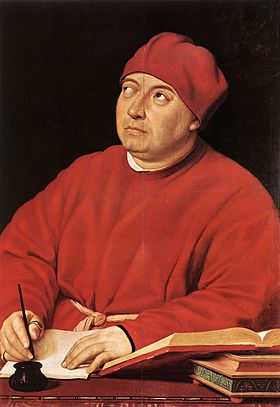- Portrait de Tommaso Inghirami
-
Portrait de Tommaso Inghirami 
Artiste Raphaël Année 1509 Type huile sur bois Dimensions (H × L) 91 cm × 61 cm Localisation Galerie Palatine et Isabella Stewart Gardner Museum, Florence et Boston, Italie et États-Unis modifier 
Le Portrait de Tommaso Inghirami ou Fedra Inghirami est une peinture à l'huile sur bois de 91 x 61 cm, datant de l'an 1509, du peintre Raphaël. Il existe deux copies du tableau dont une conservée à la Galerie Palatine, à Florence et la seconde au Isabella Stewart Gardner Museum à Boston[1].
Sommaire
Histoire
Le personnage représenté à son bureau est le prélat Tommaso Inghirami un humaniste né à Volterra en 1470 et qui était au service du pape Léon X. Très populaire orateur et acteur, il était un ami de Raphaël et était surnommé Phèdre[2],[3]. Comme on peut le voir sur son portrait, il souffrait de strabisme divergent[4].
Le tableau du Palais Pitti, qui a été probablement commissionné à Raphaël dans les premières années du séjour romain de l'artiste (1509), faisait partie de la collection du cardinal Léopold de Médicis. Après sa mort, la peinture rejoignit le Palais Pitti jusqu'en 1799, puis, suite au traité de Tolentino, elle fut emportée en France et rendue finalement au musée en 1816.
Description
Le personnage est représenté en buste assis à son bureau, tourné de trois-quart vers la gauche dans ses habits rouges sur un fond sombre, le plumier à la main devant un cahier, le regard dirigé vers le plafond à la recherche de son inspiration. Son strabisme divergent est clairement visible.
Analyse
Connu pour son réalisme et son souci du détail, le tableau rappelle les œuvres de Hans Holbein l'ancien, par lesquelles Raphaël peut avoir été influencé dans son exécution[3]. Le style rappelle un autre tableau de Raphaël le Portrait d'Agnolo Doni (1506 environ), que Claudio Strinati décrivait en 1998 comme étant d'une « clarté impitoyable »[1].
D'après le Cambridge Companion to Raphael de 2005, le tableau est « la première référence dans laquelle Raphaël a introduit la notion de mouvement », par une « torsion du corps », visible dans la composition[5]. Au moyen de ce dispositif, Raphaël détourne l'attention du spectateur de la malformation physique du sujet représenté[4],[6].
Bibliographie
- L. Cirlot, Museo del Prado II, Col. Museos del Mundo, Thome 7, p. 145, Espasa, 2007 (ISBN 978-84-674-3810-9)
- L. Monreal, Grandes Museos, Vol. 1, Planeta, 1975 (ISBN 84-320-0460-X)
- M. Olivar, Cien obras maestras de la pintura, Biblioteca Básica Salvat, 1971 (ISBN 84-345-7215-X)
- Pierluigi De Vecchi, Raffaello, Rizzoli, Milan, 1975.
- Paolo Franzese, Raffaello, Mondadori Arte, Milan 2008 (ISBN 978-88-370-6437-2)
Notes et références
- Claudio M. Strinati, Raphael [1], p. 29, accès le 24 juin 2010, 1998, publication, Giunti Editore Florence, Italie. (ISBN 9788809762510)
- suite à une habile improvisation de poésie latine lors d'un spectacle de Phèdre de Sénèque où il interprétait le principal rôle
- Frank Roy Fraprie, The Raphael book: an account of the life of Raphael Santi of Urbino and his place in the development of art, together with a description of his paintings and frescos [2] p. 272, accès le 24 juin 2010, année 1912, publication,L.C. Page & Company
- Hilliard T. Goldfarb,The Isabella Stewart Gardner Museum: a companion guide and history [3] p. 63, accès du 24 juin 2010, année 1995, publication Yale University Press (ISBN 9780300063417)
- Marcia B. Hall, The Cambridge companion to Raphael [4] p. 98, accès le 24 juin 2010, année 2005, publication Cambridge University Press, (ISBN 9780521808095)
- Marcia B. Hall,Rome [5] p. 128, accès le 24 juin 2010 et 18 avril 2005, publication Cambridge University Press (ISBN 9780521624459)
Sources
- (en) Cet article est partiellement ou en totalité issu de l’article de Wikipédia en anglais intitulé « Portrait of Tommaso Inghirami (Raphael) » (voir la liste des auteurs)
Articles connexes
- Liste de peintures de Raphaël
Liens externes
Wikimedia Foundation. 2010.
